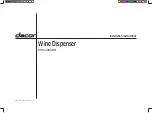
PAGE 3
The control valve uses no traditional fasteners (e.g. screws); instead clips, threaded caps and nuts and snap type latches
are used. Caps and nuts only need to be firmly hand tightened because radial seals are used. Tools required to service
the valve include one small blade screw driver, one large blade screw driver, pliers and a pair of hands. A plastic wrench
is available which eliminates the need for screwdrivers and pliers. Disassembly for servicing takes much less time than
comparable products currently on the market. Control valve installation is made easy because the distributor tube can
be cut ½” above to ½” below the top of tank thread. The distributor tube is held in place by an o-ring seal and the control
valve also has a bayonet lock feature for upper distributor baskets.
The AC adapter comes with a 15 foot power cord and is designed for use with the control valve. The AC adapter is for dry
location use only. The control valve remembers all settings until the battery power is depleted if the power goes out. After
the battery power is depleted, the only item that needs to be reset is the time of day; other values are permanently stored
in the nonvolatile memory. The control valve battery is not rechargeable but is replaceable.
INSTALLATION
Allow one foot of clearance to service the valve.
The valve will withstand transportation and storage temperatures of -13 ˚F (-25 ˚C) to 131 ˚F (55 ˚C) and for short periods
up to 158 ˚F (70 ˚C). If valve has been exposed to freezing conditions let valve warm up to room temperature before
running water through it. The valve has been packaged to prevent damage from the effects of normal humidity, vibration
and shock.
Place softener in desired location close to water supply inlet, after pressure tank, and near a source for waste water,
(utility sink, floor drain or sewer line). A 115/120V, 60 Hz uninterrupted outlet is required. Keep softener far enough away
from walls and other obstructions to allow enough room for servicing the unit. All sillcocks and similar fixtures that will
use untreated water must have their pipes connected to the hard water side of the softener. The bypass valve should be
installed so that water will be available if it should be necessary to shut off the pressure in order to service the softener.
The cabinet tank or mineral tank must be reasonably level and solidly in place. Prior to beginning work to the system,
make sure that water pressure is shut off at the incoming water supply and that several water spigots are open to provide
sufficient venting for drainage of that system.
Arrows are molded into the control valve to show the direction of the flow.
BYPASS VALVE:
The bypass valve easily connects to the control valve body using nuts that only require hand tightening.
Install with red knobs in the upward position. Press end of bypass valve with o-rings into valve. Hand tighten nuts. Place
into
BYPASS OPERATION (figure 1 page 3).
Avoid getting primer and solvent cement on any part of the o-rings or split rings, bypass valve or control valve. DO NOT
use pipe dope or any other sealant on threads. Teflon tape is not necessary on the caps because of o-ring seals. Do not
use Vaseline or other unacceptable lubricants on o-rings. A silicone lubricant may be used on black o-rings.
DRAIN LINE:
The 3/4” drain line elbow accommodates 5/8” poly tube or 3/4” NPT drain line connections. The nut and
poly tube insert for the 3/4” drain line elbow is designed for use with flexible poly tube only. The drain line elbow can be
rotated so the outlet can be oriented toward the nearest drain
Click to buy NOW!
PD
F-XCHANGE
w
ww
.docu-track.c
om
Click to buy NOW!
PD
F-XCHANGE
w
ww
.docu-track.c
om
FIGURE 1































